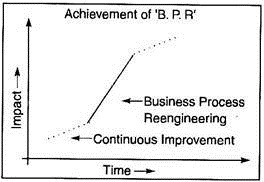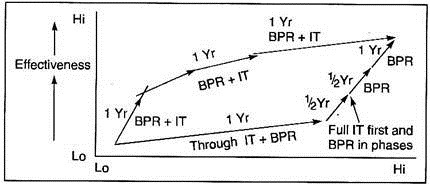Michael Hammer and James champy defined BPR as “the FUNDAMENTAL rethinking and RADICAL redesign of the business PROCESS to achieve DRAMATIC improvement in the critical contemporary measures of performance such as costs, quality, service, and speed.”
This definition contains the four key words:
Fundamental:
Why do we do what we do?
Why do we do it that way?
Radical:
Signifies getting to the root of the things, not making superficial changes in the branches or leaves of the organisation structure.
Dramatic:
Signifies not incremental but quantum leaps in performance.
Process:
Signifies that the focus should be on process in addition to the task, job, people, and structure.
The word combination ‘business process’ is a collection of activities that take one or more kind of inputs and create an output that is of value to the customers. And the focus of reengineering is: what a company must do? (and) how to do it?
BPR is the process of rethinking and redesigning in the way we work. It is characterised by totally transforming the way in which a company is organised, bringing revolutionary changes in perspective and redesigning structures and focus. BPR seeks the reduction of unnecessary work.
More often than not, it requires the total demolition of the existing process. It is a move from functional stagnation to process-orientation action. Thus, BPR promises not just incremental but dramatic levels of improvement.
The chart below highlights the process:
Here, ‘continuous improvement’ means and requires relentless and on-going search for ways to improve business performance.
Through BPR, a business system is redesigned drastically to bring in improvements in the performance measures like cost and quality, and service and speed. This is achieved through the maxim: old order changed yielding place to new.
Following the original definition and the ideas contained in it, it can be said that while going in for BPR the organisation has to take harsh measures, devoid of human face, to ensure radical changes in the existing system of working.
The ground rules for the same are:
1. Radical changes can only occur when old ways or thinking are fully replaced with new ways.
2. Concrete results of BPR must be realised quickly.
3. Information technology (IT) plays a key role in any organisational change effort.
4. Any change affects all parts of the organisation. A successful change effort, thus, must address and integrate people, technology, and structure with management philosophy.
An Indian firm, engaged in large scale projects throughout the country, has chalked out its phased programme to introduce BRR combining it with IT (Information Technology) as shown in a diagram below:
BPR is sometimes referred to as Business Process Redesign in a complete sense to achieve a new and much higher standard of performance. BPR has three basic elements:
Process simulation, quality management and cost simulation:
(i) Process simulation:
Involves the running of trials of ‘as-is’ and ‘to-be’ models to test ‘what-if’ assumptions about process improvement and reengineering;
(ii) Quality management:
Requires an approach to process control and improvement that focuses on meeting customer expectations, reducing process variation, and continuous improvement; and
(iii) Cost simulation:
That is, simulation of cost reduction opportunities that help build commitments for improvement actions. This action includes evaluation of costs and benefits of alternative approaches to process re-engineering for all functions work units.
Since any process can be reengineered in various ways depending on the levels of ambition, BPR initiatives can be categorised into:
(i) Process improvement,
(ii) Process redesign, and
(iii) Business transformation.
While process improvement is the lowest degree of BPR, process redesign is a major degree of BPR, But, business transformation is the highest degree of BPR as it aims at reinventing the business through a top-down appraisal and redesigning of the business.

